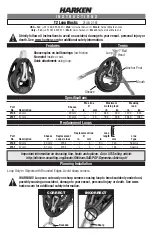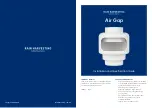
DOC-0017-07-EN: AC20 Series - EtherCAT Option
18 (58)
DOC-0017-07-EN-A 27.03.2023
8.2 Process Data
AC20 parameters implementation
The AC20 device implements CANopen over EtherCAT. The CANopen over EtherCAT (CoE) protocol
enables the complete CANopen profile family to be utilized via EtherCAT.
CANopen is object-based, meaning AC20 node has an
object dictionary
, which contains communication
objects. These communication objects cover acyclic configuration data, which is handled by
Service Data
Objects (SDOs)
; cyclic real-time data, which is handled by
Process Data Objects (PDOs).
AC20 parameters can be accessed from the network via dedicated object entries in the
Manufacturer
Specific range and the Profile range
(2001h - FFFFh). The SDO information protocol allows nodes to
retrieve the name and data type of the AC20 parameters.
Each object entry in the
manufacturer specific objects
corresponds to an AC20 parameter number, with
parameter number 1 corresponding to object index 2001h, parameter number 2 to object index 2002h, etc.
For standard parameters (of a single element), sub-index 00h of the object represents the value of the
parameter. Its data type and access depend on the AC20 parameter.
For multiple element parameters (parameter arrays), sub-index 00h represents the number of parameter
elements and sub-indexes 01h-FEh represents the value of each of the parameter elements.
In the example below parameter number 1 is a single element parameter and parameter number 2 is a 4-
element parameter array:
AC20 Parameter number
Index
Subindex Description
Type / Access
1
2001h
00h
Parameter Value
Parameter dependent
2
2002h
00h
Number of Elements
Unsigned8 / Read only
01h
value of element 0
Parameter dependent
02h
value of element 1
03h
value of element 2
04h
value of element 3
Config Mapping
The AC20 EtherCAT option requires configuration of process data mapping. Parameters mapped as
Process Data can be exchanged cyclically as Process Data Objects (PDOs) on the bus.
The AC20 EtherCAT device supports up to 6 TPDOs and up to 6 RPDOs, each supporting up to 254 SDO
(service Data Object) mappings. Each SDO equals one Process Data mapped drive parameter element.
(See Appendix – CANopen Object Dictionary).
There are two methods to define process data mapping: The process data can be mapped using the AC20
input and output mapping tables or from the PLC.
The parameter
2566 MASTERMAPPING
defines the method: If FALSE the AC20 input and output mapping
tables will be used to configure process data mapping. If TRUE, the bus master set/configures the Process
data mapping and AC20 input and output mapping tables will be cleared.
Note: For parameter
2566 MASTERMAPPING = ‘FALSE’
:
If the AC20 mapping tables are both set to
zeros or AC20 mapping tables differs from PLC mapping then the option will be mapped from the PLC.
















































